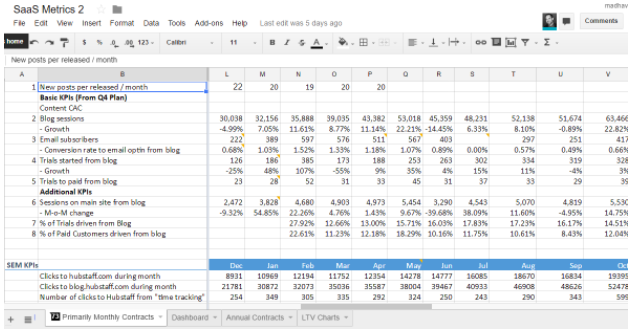
Get your FREE 30-day trial.
Please complete all fields.
As a marketing manager for Hubstaff, my role has evolved dramatically as we’ve grown the business. I have bigger responsibilities, I supervise more team members, and the complexity of the work has increased. Yet one challenge rises above all else: making sure my team takes ownership and successfully hits their goals. And not only that, but getting this accomplished independently and with minimum supervision from me.
I won’t pretend that it’s been easy. Here’s a “friendly reminder” I sent out to the team as we were working to get this process worked out:

Any experienced manager knows that the best way to manage is to get out of the way and let employees take ownership of their work. This is something I work to accomplish every day, and one thing has proven more effective than anything else: KPIs.
This post is my attempt to explain how, and to share the 3-step process I’ve used to implement a management framework to boost employee ownership, motivate quality, and drive bottom line results.
Before I dive into how I use KPIs to manage our marketing and instill ownership and accountability in my team, I want to share how KPIs affect my own performance.
At Hubstaff, I’m responsible for our search marketing strategy and our integrations partnerships. My own work focuses on the KPIs that I’m responsible to report on in my monthly meetings with Dave, our co-founder. These KPIs are specific to our search marketing and integrations channels, and each is tied directly to our overall business goals, so I know, for instance, the impact my work on our core business metrics like monthly recurring revenue (MRR).
Here’s a quick look at some of my KPIs:

These KPIs enable and empower me personally to do my best work. Here are five key ways they’re making that happen...
Being able to directly tie my own KPIs to the success of the company gives my work meaning that would otherwise be hard to instill. These KPIs allow me to take ownership; I feel a sense of pride when we hit our goals, and question my own strategies when we don’t.
I use these KPIs to establish benchmarks, as well. Instead of “flying blind,” I can see at-a-glance how my current performance compares to previous months. I know when I’m ahead of pace, and when I’m behind. Like a runner with his eye on the finish line, these benchmarks give me a sense of purpose, and motivates me to the do the best I can.
By tracking our KPIs, I’m also motivated to grow our numbers month over month. In order to improve performance, I’m continually forced to re-think my approach with the same resources, eventually allowing us to develop more efficient marketing strategies.
KPIs allow us to set priorities based on long-term, quantitative results rather than “educated guesses” or gut feelings, which can be skewed by emotion, circumstance, or limited data. If tactic A consistently outperforms tactic B, I’ll prioritize tactic A. If tactic C suddenly shows promise but won’t immediately help us reach our goal, I’ll move tactic C aside and and put the full focus back on tactic A.
For example, it was this kind of KPI-driven prioritization that drove our decision to end our curated newsletter.
Letting KPIs drive our strategy means no one has to assign me tasks. I have my own KPIs and how I hit those goals is entirely up to me (within reason and budget — we’re a bootstrapped company). This doesn’t mean I work alone. I have monthly meetings with Dave where I report progress on all strategies and tactics within the channels, and he shares his feedback and advice.
This is a big one. Focusing on KPIs means my marketing efforts are less formulaic and more entrepreneurial. It’s about problem-solving. Since I’m able to see the connection between my own channels’ numbers and our overall business numbers, I’m able to figure out which tactics are affecting the bottom line and which aren’t.
Unfortunately, I didn’t always manage my team the same way, and there was a huge problem: I was delegating tasks instead of delegating authority. Essentially, I was pushing my team to do tasks and follow processes that they had no real say in. The results weren’t pretty:
Team members were disinterested in their work
Communication broke down
Accountability was lacking
Quality suffered
Feedback loops multiplied
I lost my mind trying to train new team members
I soon realized that the very KPI-based system I’d put in place to manage my own work was exactly what I needed to implement in order to better manage and empower my team members. If I could see how each marketing channel impacted the business overall, why couldn’t we do the same things at a more granular level, using KPIs to better manage every strategy, tactic, and task?
Annie Musgrave over at ChartMogul sums it up nicely:
“Drawing the connection between individual contributions and MRR helps each employee understand their impact and create a data-driven culture.”
Geoff Roberts of Roambi is even more blunt:
“If you want to move numbers in the right direction, you need to get people to care about them.”
Keeping this in mind, I decided to replicate the same KPI-driven ownership philosophy I’d applied to my own work, and use it to empower my team members. My goal was that everyone has some level of ownership and can see their contribution to the business.
The dream:
The team OWNS and NAILS their numbers month over month
Everyone is always motivated
I am minimally involved in helping people perform at their best levels
Madhav is a marketing manager at Hubstaff, a time tracking software that integrates with Salesforce. He helps acquire customers with high ROI marketing experiments, action focused analytics and product iterations. You can find more of his work on his personal blog.